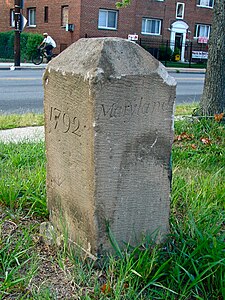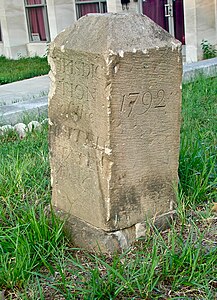Boundary markers of the original District of Columbia

The boundary markers of the original District of Columbia are the 40 milestones that marked the four lines forming the boundaries between the states of Maryland and Virginia and the square of 100 square miles (259 km2) of federal territory that became the District of Columbia in 1801 (see: Founding of the District of Columbia). Working under the supervision of three commissioners that President George Washington had appointed in 1790 in accordance with the federal Residence Act, a surveying team led by Major Andrew Ellicott placed these markers in 1791 and 1792. Among Ellicott's assistants were his brothers Joseph and Benjamin Ellicott, Isaac Roberdeau, George Fenwick, Isaac Briggs and an African American astronomer, Benjamin Banneker.[1]
Today, 36 of the original marker stones survive as the oldest federally placed monuments in the United States. Thirteen of these markers are now within Virginia due to the return of the portion of the District south and west of the Potomac River to Virginia in 1846 (see: District of Columbia retrocession).
Geography
[edit]
The District of Columbia (initially, the Territory of Columbia) was originally specified to be a square 100 square miles (260 km2) in area, with the axes between the corners of the square running north-south and east-west, The square had its southern corner at the southern tip of Jones Point in Alexandria, Virginia, at the confluence of the Potomac River and Hunting Creek (later the site of the Jones Point Lighthouse).[2] The sides of the square were each 10 miles (16 km) long. The specified orientation results in a diamond shape for the District's original boundaries on most maps.
The north-south axis of the District's current boundaries extends southward from the District's north corner near East-West Highway (Maryland Route 410), travels between 17th and 18th Streets, N.W., and continues south across the National Mall to the far shore of the Potomac River; the east-west axis is between the present Constitution Avenue and C Street, N.E. and N.W.[3]
These axes are not the lines used to define the four geographical quadrants of the District (N.E., N.W., S.E., and S.W.), commonly appended to Washington street addresses, which are delimited generally by North Capitol Street, East Capitol Street, South Capitol Street, and the National Mall. The center of the square is west of the Ellipse and north of the Mall, within the grounds of the headquarters of the Organization of American States.[4]
In 2011, the District of Columbia geographic information system (GIS) program completed a project to map the District's boundary using Global Positioning System (GPS) and contemporary survey technology at an accuracy of ±5 centimetres (2.0 in) horizontally and ±9 centimetres (3.5 in) vertically. The GIS program's survey found that (listed in the order in which Andrew Ellicott's team performed the initial boundary survey):
- Along the northwest boundary, the stones are outside the existing boundary ranging from 4.43 feet (1.35 m) to 9.6 feet (2.93 m)
- Along the northeast boundary, the stones are inside the existing boundary ranging from 6.6 feet (2.01 m) to 8.4 feet (2.56 m)
- Along the southeast boundary, the stones are outside the existing boundary ranging from 12.75 feet (3.89 m) to 18.48 feet (5.63 m)
The overall accuracy of the historic survey and the survey using 2011 technology produced remarkably similar results. For example, the distance between Southeast stones numbers 6 and 7 is 5,280.824 feet (1,609.5952 m), almost exactly one mile (5,280 feet (1,609.3440 m)).[5]
The stones are located alongside streets, in public parks, deep in the woods and on personal property. Homeowners with stones on their property are generally willing to let the curious take a closer look if they are respectful.[6]
Placement of the boundary stones
[edit]
On March 30, 1791, President George Washington issued a proclamation that established ″Jones's point, the upper cape of Hunting Creek in Virginia″ as the starting point for the federal territory's boundary survey.[7] Acting in accordance with instructions in the proclamation, the survey team then began its work at the square's south corner on the shoreline of the point, which was at the southeast corner of Alexandria, Virginia.[2][8][9] On April 15, 1791, officials dedicated the south corner stone in an elaborate Masonic ceremony at a point that Andrew Ellicott had determined.[2][10][11]
The survey team then cleared a corridor along the boundary route to facilitate surveying, traveling clockwise from the point and placing sandstone boundary markers at the four corners and at intervals of approximately one mile.[2][8] The markers were quarried near Aquia Creek in Virginia.[2] Most weighed about a half-ton at their emplacement; the four cornerstones were slightly larger. The Virginia stones were set in 1791, and the Maryland ones in 1792.[2] The map on the web page "Boundary Stones of the District of Columbia" identifies the location of each of the four corner stones, and those of the still-in-place intermediate stones.[12]
The side of a boundary marker that faced the federal territory was inscribed "Jurisdiction of the United States" and with the distance in miles and poles from the previous corner stone. The opposite side was marked with the name of the border state: Virginia or Maryland. The remaining sides were marked with the year that the team placed the stones and with the variation ("Var.") of the compass needle at that place.[2][13][14]
On January 1, 1793, Andrew Ellicott submitted to the commissioners a report that stated that the boundary survey had been completed and that all of the boundary marker stones had been set in place. Ellicott's report described the marker stones and contained a map that showed the boundaries and topographical features of the Territory of Columbia. The map identified the locations within the Territory of the planned City of Washington and its major streets, as well as the location of each boundary marker stone.[2][15]
The following images show the sides of the Southeast No. 6 boundary marker stone on August 17, 2011:
-
From north
-
From east
-
From south
-
From west
Protection and historical designations
[edit]
Protection
[edit]In 1906, Fred E. Woodward read a paper to the Columbia Historical Society that described the history, location and conditions of each of the remaining boundary stones, together with photographs of each. His paper concluded by recommending that the stones be protected by placing small fences around each one.[16] In 1909, Ernest A. Shuster of the United States Geological Survey wrote an article for the National Geographic Magazine that described his visits to the 36 remaining boundary stones and that urged their protection and preservation.[17]
In 1915, various local chapters of the Daughters of the American Revolution (DAR) began to place fences around each of the markers.[2][10][12] The DAR also placed at the exact center of the original federal territory a marker stone that was located about a half of a mile from the White House and was near the DAR's Memorial Continental Hall.[10]
Historical designations
[edit]One Virginia boundary marker was added to the National Register of Historic Places in 1976, and another in 1980. In 1991, the remaining Virginia boundary markers were added to the National Register in response to a Multiple Property Submission that the Virginia DAR had submitted.[18] In 1996, 23 marker stones along the boundary between the District of Columbia and Maryland were added to the National Register in response to registration forms that the District of Columbia government had submitted for each of the stones. Each of the District's registration forms referenced the documentation in the Multiple Property Submission for the Virginia markers.[19][20]
Virginia
[edit]Southwest 9.[21] This boundary marker in Falls Church, Virginia was added to the National Register of Historic Places, and further was named a U.S. National Historic Landmark, in 1976 at the instigation of the Afro-American Bicentennial Corporation, which gave the stone its name: Benjamin Banneker: SW-9 Intermediate Boundary Stone.[22] It was the first of the boundary markers to be listed on the National Register of Historic Places.
South Corner.[23] This boundary marker in Virginia was added to the National Register of Historic Places in 1980, together with Alexandria's Jones Point Lighthouse. In 1794, the marker replaced the marker that officials had dedicated during the 1791 Masonic ceremony.[24]
Southwest 1, 2, 3, 4, 5, 6, 7, and 8; West Corner; Northwest 1, 2, and 3. These boundary markers in Virginia were added to the National Register of Historic Places on February 1, 1991 in response to the Multiple Property Submission cited above.[18]
District of Columbia and Maryland
[edit]Northwest 4, 5, 6, 7, 8, and 9; North Corner; Northeast 2, 3, 4, 5, 6, 7, 8, and 9; East Corner; Southeast 1, 2, 3, 5, 6, 7, and 9. These boundary markers, located along the border between the District of Columbia and Maryland, were added to the National Register of Historic Places on November 1, 1996.[19][25]
Preservation efforts
[edit]In 1976, the National Capital Planning Commission published a report that described the history and condition of each boundary stone.[2] The report recommended that measures be taken to assure the stones' preservation.[2] In 1990 and 1991, a resurveying team to celebrate the boundary markers' bicentennial located two of the then-missing stones.[12]
In 1995, the Northern Virginia Boundary Stones Committee, whose establishment the Northern Virginia Regional Commission (NVRC) had requested, issued a list of recommendations intended to document and preserve the 14 boundary stones that were located in Virginia. The Committee included representatives of the State of Maryland and of Arlington and Fairfax counties and the cities of Alexandria and Falls Church in Virginia.[26]
In 2008, the NVRC announced that four Virginia local governments, including Arlington and Fairfax counties and the cities of Alexandria and Falls Church, had agreed to help fund a project to protect and preserve the boundary stones by providing matching funds to a Transportation Enhancement Grant that the District Department of Transportation (DDOT) had received from the Federal Highway Administration (FHA). The announcement stated that the NVRC was working on an agreement with the DDOT, the National Park Service and the FHA to administer the project.[27]
However, the preservation project had not yet begun by 2012. It appeared that the DDOT no longer had the funds that had been allocated for the project.[28] In the meantime, teams of volunteers had begun to landscape and repaint the fences surrounding the stones.[29] In addition, the District of Columbia DAR restored the Northeast No. 7 boundary marker and its fence in 2012.
In 2014, the National Park Service, the historic preservation staff of the District of Columbia Office of Planning, the DDOT and the DAR initiated an effort to rehabilitate the boundary markers that were located along the District's contemporary boundaries.[30] As part of the project, in January 2015 a DDOT crew unearthed a stone buried in 1962 that had replaced Southeast No. 8, with the intention of cleaning and restoring the marker.[31] However, in 2016, the stone was replaced by a new stone that presumably replicated the appearance of the original stone when the original was new.[32]
List of boundary stones
[edit]The 36 extant and four missing boundary stones are tabulated in sequence below, beginning at the southern corner and proceeding clockwise, in the same order as the stones were placed.[12] The tables also contain the year that each stone was listed on the National Register of Historic Places.
Southern corner
[edit]| Name | Image | Address | City/County | Coordinates | Status | Year Listed |
|---|---|---|---|---|---|---|
| South Cornerstone of the Original District of Columbia[33] | 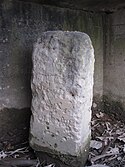 2010
|
Seawall south of lighthouse, Jones Point Park, 1 Jones Point Drive, Alexandria | City of Alexandria, Virginia; Prince George's County, Maryland | 38°47′25″N 77°02′26″W / 38.79033915°N 77.04058603°W | Extant | 1980 |
Southwestern side
[edit]| Name | Image | Address | City/County | Coordinates | Status | Year Listed |
|---|---|---|---|---|---|---|
| Southwest No. 1 Boundary Marker of the Original District of Columbia[34] | 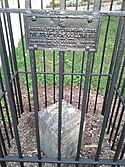 2012
|
1220 Wilkes Street | City of Alexandria, Virginia | 38°48′04″N 77°03′16″W / 38.80124355°N 77.05439303°W | Extant | 1991 |
| Southwest No. 2 Boundary Marker of the Original District of Columbia[35] | 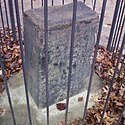 2006
|
7 Russell Road. East side of Russell Road, north of intersection with King Street | City of Alexandria, Virginia | 38°48′27″N 77°03′45″W / 38.80759243°N 77.06263792°W | Replacement marker stone (Original stone missing)[35] | 1991 |
| Southwest No. 3 Boundary Marker of the Original District of Columbia[36] |  2013
|
2952 King Street, in parking lot of First Baptist Church | City of Alexandria, Virginia | 38°49′14″N 77°04′46″W / 38.82065264°N 77.0793202°W | Extant | 1991 |
| Southwest No. 4 Boundary Marker of the Original District of Columbia[37] | 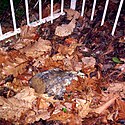 2006
|
King Street north of intersection with Wakefield Street | City of Alexandria and Arlington County, Virginia | 38°49′54″N 77°05′35″W / 38.83154299°N 77.09318693°W | Extant | 1991 |
| Southwest No. 5 Boundary Marker of the Original District of Columbia[38] | 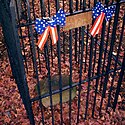 2006
|
Northeast of intersection of King Street and Walter Reed Drive | Arlington County, Virginia | 38°50′31″N 77°06′24″W / 38.84208118°N 77.10674008°W | Extant | 1991 |
| Southwest No. 6 Boundary Marker of the Original District of Columbia[39] | 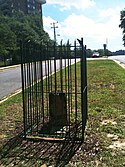 2012
|
South Jefferson Street south of intersection with Columbia Pike, in median strip | Arlington and Fairfax Counties, Virginia | 38°51′07″N 77°07′09″W / 38.85186534°N 77.11926358°W | Extant | 1991 |
| Southwest No. 7 Boundary Marker of the Original District of Columbia[40] | 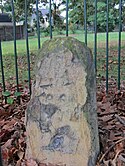 2012
|
Behind 3101 South Manchester Street, Arlington, Virginia, in fence southwest of Carlin Springs Elementary School (5995 5th Road South, Arlington, Virginia) parking lot | Arlington and Fairfax Counties, Virginia | 38°51′45″N 77°07′58″W / 38.86237205°N 77.13272594°W | Extant | 1991 |
| Southwest No. 8 Boundary Marker of the Original District of Columbia[41] | 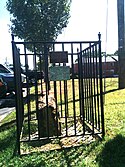 2012 |
South of intersection of Wilson Boulevard and John Marshall Drive, near parking lot behind apartment building and 100 feet (30.5 m) south of water tower | Arlington County and the City of Falls Church, Virginia | 38°52′22″N 77°08′45″W / 38.87267119°N 77.14594527°W | Extant | 1991 |
| Benjamin Banneker: SW-9 Intermediate Boundary Stone[42] | 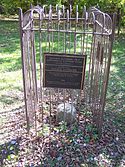 2012
|
West side of Benjamin Banneker Park, 1701 North Van Buren Street, Falls Church, Virginia, between 18th Street North and Four Mile Run | Arlington County and the City of Falls Church, Virginia | 38°52′59″N 77°09′33″W / 38.88294291°N 77.15909006°W | Extant | 1976 |
Western corner
[edit]| Name | Image | Address | City/County | Coordinates | Status | Year Listed |
|---|---|---|---|---|---|---|
| West Cornerstone[43] | 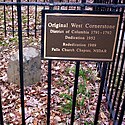 2005
|
In Andrew Ellicott Park at the West Cornerstone, 2824 N. Arizona Street, Arlington, Virginia[44] | Arlington County, City of Falls Church, and Fairfax County, Virginia | 38°53′36″N 77°10′20″W / 38.89324513°N 77.17230114°W | Extant | 1991 |
Northwestern side
[edit]| Name | Image | Address | City/County | Coordinates | Status | Year Listed |
|---|---|---|---|---|---|---|
| Northwest No. 1 Boundary Marker of the Original District of Columbia[45] | 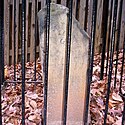 2006
|
3607 North Powhatan Street, Arlington, Virginia | Arlington and Fairfax counties, Virginia | 38°54′13″N 77°09′33″W / 38.90356154°N 77.15914435°W | Extant | 1991 |
| Northwest No. 2 Boundary Marker of the Original District of Columbia[46] | 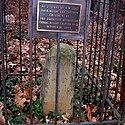 2005
|
5145 38th Street North, Arlington, Virginia | Arlington and Fairfax counties, Virginia | 38°54′50″N 77°08′46″W / 38.91388113°N 77.14598738°W | Extant | 1991 |
| Northwest No. 3 Boundary Marker of the Original District of Columbia[47] | 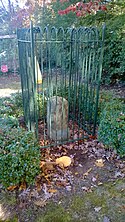 2013
|
4013 North Tazewell Street, Arlington, Virginia | Arlington and Fairfax counties, Virginia | 38°55′29″N 77°07′56″W / 38.92463321°N 77.13223642°W | Extant | 1991 |
| Northwest No. 4 Boundary Marker of the Original District of Columbia[48] | 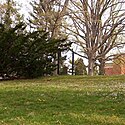 2006
|
Dalecarlia Water Treatment Plant grounds, 100+ feet east of the Capital Crescent Trail and several hundred feet north of the intersection of Norton Street and Potomac Avenue | Washington, D.C., and Montgomery County, Maryland | 38°56′15″N 77°06′56″W / 38.93760599°N 77.11567162°W | Extant | 1996 |
| Northwest No. 5 Boundary Marker of the Original District of Columbia[49] | 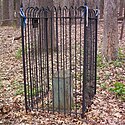 2006
|
Dalecarlia Reservoir, 600 feet (180 m) west of Dalecarlia Parkway and 300 feet (91 m) southeast of concrete culvert | Washington, D.C., and Montgomery County, Maryland | 38°56′41″N 77°06′24″W / 38.94463908°N 77.10668154°W | Extant | 1996 |
| Northwest No. 6 Boundary Marker of the Original District of Columbia[50] |  2006 |
150 feet (46 m) northeast of intersection of Park and Western Avenues, Northwest | Washington, D.C., and Montgomery County, Maryland | 38°57′18″N 77°05′37″W / 38.9549086°N 77.09354761°W | Extant | 1996 |
| Northwest No. 7 Boundary Marker of the Original District of Columbia[51] | 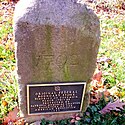 2006
|
5600 Western Avenue | Washington, D.C., and Montgomery County, Maryland | 38°57′55″N 77°04′50″W / 38.965194°N 77.080417°W | Extant | 1996 |
| Northwest No. 8 Boundary Marker of the Original District of Columbia[52] | 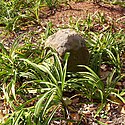 2005
|
6422 Western Avenue | Washington, D.C., and Montgomery County, Maryland | 38°58′32″N 77°04′02″W / 38.97544235°N 77.06726693°W | Extant | 1996 |
| Northwest No. 9 Boundary Marker of the Original District of Columbia[53] |  2021
|
Rock Creek Park, approximately 165 feet (50 m) northwest of the centerline of Daniel Road and 5 feet (1.5 m) southeast from edge of 2701 Daniel Road | Washington, D.C., and Montgomery County, Maryland | 38°59′09″N 77°03′15″W / 38.98569855°N 77.05412886°W | Extant | 1996 |
Northern corner
[edit]| Name | Image | Address | City/County | Coordinates | Status | Year Listed |
|---|---|---|---|---|---|---|
| North Corner Boundary Marker of the Original District of Columbia[54] |  2014
|
1880 block of East-West Highway (south side) | Washington, D.C., and Montgomery County, Maryland | 38°59′45″N 77°02′28″W / 38.99595651°N 77.04098558°W | Extant | 1996 |
Northeastern side
[edit]| Name | Image | Address | City/County | Coordinates | Status | Year Listed |
|---|---|---|---|---|---|---|
| Northeast No. 1 Boundary Marker of the Original District of Columbia[55] |  2005
|
7847 Eastern Ave, Silver Spring, MD 20910 | Washington, D.C., and Montgomery County, Maryland | 38°59′08″N 77°01′40″W / 38.985648°N 77.027773°W | Plaque in sidewalk (marker stone missing) | |
| Northeast No. 2 Boundary Marker of the Original District of Columbia[56] | 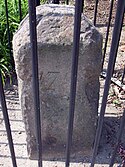 2005
|
6980 Maple Avenue, Takoma Park, Maryland | Washington, D.C., and Montgomery County, Maryland | 38°58′31″N 77°00′53″W / 38.975351°N 77.014594°W | Extant | 1996 |
| Northeast No. 3 Boundary Marker of the Original District of Columbia[57] | 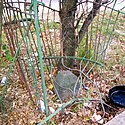 2013
|
6201 Eastern Avenue, 110 feet (33.5 m) northwest of intersection with Chillum Road | Washington, D.C., and Prince George's County, Maryland | 38°57′55″N 77°00′06″W / 38.9652726°N 77.00169083°W | Extant | 1996 |
| Northeast No. 4 Boundary Marker of the Original District of Columbia[58] | 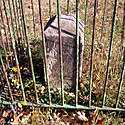 2006
|
5101 Eastern Avenue/5400 Sargent Road | Washington, D.C., and Prince George's County, Maryland | 38°57′17″N 76°59′18″W / 38.9547328°N 76.98820728°W | Extant | 1996 |
| Northeast No. 5 Boundary Marker of the Original District of Columbia[59] | 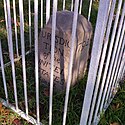 2006
|
4609 Eastern Avenue | Washington, D.C., and Prince George's County, Maryland | 38°56′40″N 76°58′30″W / 38.94441385°N 76.97500885°W | Extant | 1996 |
| Northeast No. 6 Boundary Marker of the Original District of Columbia[60] | 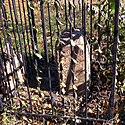 2005
|
3601 Eastern Avenue | Washington, D.C., and Prince George's County, Maryland | 38°56′01″N 76°57′41″W / 38.93371492°N 76.96132996°W | Extant | 1996 |
| Northeast No. 7 Boundary Marker of the Original District of Columbia[61] |  2013
|
Fort Lincoln Cemetery, along fence, 75 feet southwest of Garden Mausoleum | Washington, D.C., and Prince | 38°55′26″N 76°56′55″W / 38.9237882°N 76.94864949°W | Extant | 1996 |
| Northeast No. 8 Boundary Marker of the Original District of Columbia[62] | 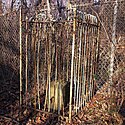 2005
|
Kenilworth Park and Aquatic Gardens, along a fence 500 feet northwest of the intersection of Eastern and Kenilworth Avenues | Washington, D.C., and Prince George's County, Maryland | 38°54′49″N 76°56′08″W / 38.9134828°N 76.93548331°W | Extant | 1996 |
| Northeast No. 9 Boundary Marker of the Original District of Columbia[63] | 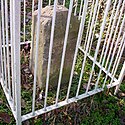 2005
|
919 Eastern Avenue | Washington, D.C., and Prince George's County, Maryland | 38°54′11″N 76°55′20″W / 38.9031689°N 76.92231955°W | Extant | 1996 |
Eastern corner
[edit]| Name | Image | Address | City/County | Coordinates | Status | Year Listed |
|---|---|---|---|---|---|---|
| East Corner Boundary Marker of the Original District of Columbia[64] | 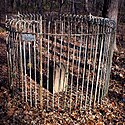 2005
|
100 feet (30 m) east of intersection of Eastern and Southern Avenues | Washington, D.C., and Prince George's County, Maryland | 38°53′34″N 76°54′33″W / 38.8928605°N 76.90916553°W | Extant | 1996 |
Southeastern side
[edit]| Name | Image | Address | City/County | Coordinates | Status | Year Listed |
|---|---|---|---|---|---|---|
| Southeast No. 1 Boundary Marker of the Original District of Columbia[65] |  2005
|
30 feet (9.1 m) south of intersection of Southern Avenue and D Street | Washington, D.C., and Prince George's County, Maryland | 38°52′58″N 76°55′20″W / 38.8826400°N 76.92229346°W | Extant | 1996 |
| Southeast No. 2 Boundary Marker of the Original District of Columbia[66] |  2011
|
4345 Southern Avenue | Washington, D.C., and Prince George's County, Maryland | 38°52′21″N 76°56′08″W / 38.87241045°N 76.93542433°W | Extant | 1996 |
| Southeast No. 3 Boundary Marker of the Original District of Columbia[67] | 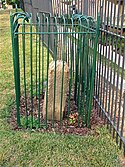 2011
|
3908 Southern Avenue | Washington, D.C., and Prince George's County, Maryland | 38°51′44″N 76°56′55″W / 38.8621606°N 76.94857084°W | Extant | 1996 |
| Southeast No. 4 Boundary Marker of the Original District of Columbia[68] |  1906
|
3101 Southern Avenue, along gate in front of parking lot south of intersection with Naylor Road. | Washington, D.C., and Prince George's County, Maryland | 38°51′06″N 76°57′43″W / 38.851756°N 76.961934°W | Replacement marker stone (Original displayed off-site in 2016)[69] |
|
| Southeast No. 5 Boundary Marker of the Original District of Columbia[70] |  2011
|
280 feet (85 m) northeast of intersection of Southern Avenue and Valley Terrace | Washington, D.C., and Prince George's County, Maryland | 38°50′30″N 76°58′29″W / 38.84168253°N 76.97483942°W | Extant | 1996 |
| Southeast No. 6 Boundary Marker of the Original District of Columbia[71] |  2011
|
901 Southern Avenue | Washington, D.C., and Prince George's County, Maryland | 38°49′53″N 76°59′17″W / 38.83143717°N 76.9879733°W | Extant | 1996 |
| Southeast No. 7 Boundary Marker of the Original District of Columbia[72] |  2011
|
25 feet (7.6 m) south of intersection of Southern Avenue and Indian Head Highway, on east side of Indian Head Highway | Washington, D.C., and Prince George's County, Maryland | 38°49′16″N 77°00′04″W / 38.82119652°N 77.00109645°W | Extant | 1996 |
| Southeast No. 8 Boundary Marker of the Original District of Columbia[73] |  1906
|
Behind Blue Plains Impoundment Lot: Southeast corner of lot on the Maryland side of the fence, a short distance from the lightposts. | Washington, D.C., and Prince George's County, Maryland | 38°48′39″N 77°00′51″W / 38.81091966°N 77.01425046°W | Replacement marker stone (Original missing)[32] |
|
| Southeast No. 9 Boundary Marker of the Original District of Columbia[74] | 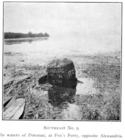 1907
|
1,000 feet (300 m) southwest of the southern end of Oxon Cove Bridge and about 200 feet (61 m) east of the Potomac River[75] | Washington, D.C., and Prince George's County, Maryland | 38°48′13″N 77°01′25″W / 38.803728°N 77.023569°W | Extant | 1996 |
Plaques
[edit]Explanatory plaques that are not attached to fences accompany several boundary marker stones, including:
-
South cornerstone
(2010) -
Southwest No. 6
(2012) -
Northeast No. 7 preservation plaque
(2013)
Historical markers
[edit]In 2005, the Arlington County, Virginia, government erected historical markers near the Southwest Nos. 6 and 8 boundary marker stones of the original District of Columbia.
-
Southwest No. 6 historical marker
(2012) -
Southwest No. 8 historical marker
(2012)
Missing boundary markers
[edit]Four of the forty original boundary markers were not in or near their original locations in late 2016. Three of these had been replaced with substitute markers.[12]
| Name | Image | Description |
|---|---|---|
| Southwest No. 2 |  2013 |
The original Southwest No. 2 marker disappeared before 1900. A marker stone now within a DAR fence near the street curb at 7 Russell Road north of King Street in Alexandria is a replacement about 0.35 miles (0.6 km) southeast of the original location. DAR records show that the replacement marker was placed at its current location in 1920. The replacement marker lacks an inscription and does not resemble an original boundary marker.[35] |
| Northeast No. 1 | 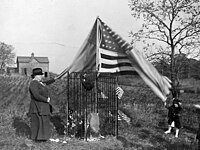 |
A photograph taken on June 13, 1916, shows a ceremony that members of the DAR conducted when they unveiled a fence around Northeast No. 1, which was then in a field.[2] The stone was accidentally bulldozed and removed in September 1952 during the construction of a storefront at 7847 Eastern Avenue, northwest of the avenue's intersection with Georgia Avenue. A bronze plaque in the sidewalk in front of a shop at the site marks the stone's former location.[76] |
| Southeast No. 4 | Southeast No. 4, described as an "indistinguishable nub", was located in 1976 along Southern Avenue a few feet southeast of the avenue's intersection with Naylor Road.[2] When a truck knocked the stone out of place in 1985, the manager of a nearby apartment building moved it into the building's boiler room for safekeeping.[77] In 1991, the building manager gave the stone to the bicentennial resurveying team.[77] A team member then stored the stone in his garage.[78] In 2012, the stone was transferred to the D.C. Office of the Surveyor, which intended to reset the stone near its original location.[77] However, in 2016, a replica of the stone resembling the presumed appearance of the original stone when new was placed near the original stone's site.[79] The original stone was placed on display in the Office of the Surveyor.[69] | |
| Southeast No. 8 | The original Southeast No. 8 stone was removed in 1958 during construction and then either lost or stolen from a storage facility before it could be reset in the ground.[32] In 1962, the DAR placed a new inscription-less stone in the same location along with the original stone's iron fence. However, further construction subsequently buried the replacement stone.[32] The replacement stone was later discovered nearly eight feet below ground level in the southeast corner of the Blue Plains Impoundment Lot, on the Maryland side of the impoundment lot's fence.[32] A concrete pipe embedded in a mound of gravel was put in place to mark the replacement stone's site. In 1972, the stone had been uncovered, and an excavation and relocation was planned, but never happened and the stone was again covered by landfill until 1991. A bicentennial resurveying team then dug it out of the ground, using old photographs to locate it. The stone was replaced underground for protection and covered by a taller pipe that was visible above the surface.[80] In 2015, DDOT workers excavated and removed the stone after debris in the pipe had covered the stone.[31][32] The stone was replaced in early 2016 with a replica that presumably had the same appearance as the original had when new. This replica was installed at ground level at the stone's original site.[32] |
District of Columbia entrance markers
[edit]A group of entrance markers, erected later along major roads that travel into the District of Columbia, are located on or near the boundary of D.C. and Maryland. Three pairs of marker stones and another single stone are known collectively as the Garden Club of America Entrance Markers.[81][82] They are all listed on the National Register of Historic Places.[82]
- One pair of markers is located within Westmoreland Circle at the junction of Western Avenue and Massachusetts Avenue NW.[81][83] These markers are between the Northwest No. 5 and Northwest No. 6 boundary markers of the original District of Columbia.
- Two similar markers flank Wisconsin Avenue at Western Avenue in Friendship Heights, near the Friendship Heights Metro Station.[84][85]
These markers are between the Northwest No. 6 and Northwest No. 7 boundary markers of the original District of Columbia.
- Another pair of markers is located within Chevy Chase Circle, at the junction of Western Avenue and Connecticut Avenue.[86][87] These markers are between the Northwest No. 7 and Northwest No. 8 boundary markers of the original District of Columbia.
- A single marker is located within a traffic island at the intersection of Georgia Avenue, Alaska Avenue and Kalmia Road NW. The marker is located inside the triangular island's southeast corner, near the intersection of Georgia Avenue to the east and Kalmia Road to the south.[88]
- The marker was formerly located inside a median in the center of Georgia Avenue, just north of the Avenue's intersection with Kalmia Road and Alaska Avenue.[89] This marker is between the former site of the Northeast No. 1 and the present site of the Northeast No. 2 boundary markers of the original District of Columbia.
Another D.C. entrance marker stands in a traffic circle (Blair Circle) near downtown Silver Spring, Maryland, at the junction of Eastern Avenue NW, 16th Street NW, N. Portal Drive NW and Colesville Road.[90] The marker is between the North Corner boundary marker and the former site of the Northeast No. 1 boundary marker of the original District of Columbia.
-
One of the Garden Club of America Entrance Markers in Friendship Heights (2005)
-
D.C. entrance marker in traffic circle near downtown Silver Spring (2011)
See also
[edit]- History of Washington, D.C.
- Index of Washington, D.C.-related articles
- List of Registered Historic Places in the District of Columbia
- List of Registered Historic Places in Virginia
- Outline of Washington, D.C.
References
[edit]- ^ (1) Bedini, Silvio A. (1969). "Benjamin Banneker and the Survey of the District of Columbia, 1791" (PDF). Records of the Columbia Historical Society. 69/70. Washington, D.C.: Columbia Historical Society: 7–30. JSTOR 40067703. OCLC 3860814. Archived from the original (PDF) on October 7, 2017. Retrieved January 13, 2013 – via Boundary Stones of the District of Columbia.
(2) Bedini, Silvio A. (Spring–Summer 1991). "The Survey of the Federal Territory: Andrew Ellicott and Benjamin Banneker". Washington History. 3 (1). Washington, D.C.: Historical Society of Washington, D.C.: 81, 83, 86. JSTOR 40072968.
(3) Mathews, Catharine Van Cortlandt (1908). "Chapter IV: The City of Washington in the Territory of Columbia, 1791–1793". Andrew Ellicott: His Life and Letters. Grafton Press. pp. 81–86. Retrieved January 29, 2018 – via Internet Archive.
(4) Tindall, William (1914). Standard History of the City of Washington From a Study of the Original Sources. Knoxville, Tennessee: H. W. Crew and Company. pp. 150–151. OCLC 7059152. Retrieved March 31, 2016 – via Internet Archive. - ^ a b c d e f g h i j k l m National Capital Planning Commission (1976). Boundary markers of the Nation's Capital: a proposal for their preservation & protection: a National Capital Planning Commission Bicentennial report. Washington, D.C.: National Capital Planning Commission; For sale by the Superintendent of Documents, United States Government Printing Office. OCLC 3772302. Retrieved February 22, 2016 – via HathiTrust Digital Library.
- ^ The north-south axis is a straight line connecting the north and south cornerstones of the original District of Columbia. The east-west axis is a straight line connecting the east and west cornerstones of the original District of Columbia.
- ^ Coordinates of the center of the square of the original District of Columbia: 38°53′35″N 77°02′27″W / 38.893098°N 77.040799°W The center of the square of the original District of Columbia is the crossing of the north-south axis line and the east-west axis line.
- ^ "Historic Review of the District's Boundary Stones Using GPS and Modern Survey Technology: Accurately mapping the District of Columbia boundary for the DC GIS". Office of the Chief Technology Officer: Government of the District of Columbia (DC.gov). November 1, 2011. Archived from the original on October 11, 2017. Retrieved October 11, 2017.
- ^ "Boundary Stones: The quest to save DC's 1st federal monuments". WTOP. April 10, 2018. Retrieved September 16, 2019.
- ^ Washington, George (1792). "Proclamation: Georgetown, March 30, 1791". In John C. Fitzpatrick (ed.). The Writings of George Washington from the Original Manuscript Sources: 1745-1799. Vol. 31: January 22, 1790—March 9, 1792. Washington: United States Government Printing Office (August, 1939). Retrieved October 7, 2016.
Now therefore for the purposes of amending and completing the location of the whole of the said territory of the ten miles square in conformity with the said amendatory act of Congress, I do hereby declare and make known that the whole of said territory shall be located and included within the four lines following, that is to say: Beginning at Jones's point, the upper cape of Hunting Creek in Virginia, and at an angle in the outset of 45 degrees west of the north: ...
- ^ a b Bedini, Silvio A. (1970). "Benjamin Banneker and the Survey of the District of Columbia, 1791" (PDF). Records of the Columbia Historical Society. 47. Washington, D.C.: Columbia Historical Society: 7–30. Archived from the original (PDF) on September 1, 2018. Retrieved November 18, 2018.
- ^ "The 1790s: Place in Time". Discovering the Decades: Alexandria Archaeology Looks Back at 250 Years of Alexandria History. Government of the City of Alexandria, Virginia. Archived from the original on August 29, 2008. Retrieved January 5, 2013.
- ^ a b c "District of Columbia". Nineteenth Report of the National Society of the Daughters of the American Revolution: October 11, 1915 to October 11, 1916, 64th Congress, 2nd Session, Senate, Document No. 710. Washington, D.C.: Government Printing Office: 104–107. 1917. OCLC 1062842688. Retrieved October 8, 2016.
- ^ "New Federal City" (PDF). Columbian Centennial. No. 744. Boston, Massachusetts: Benjamin Russell. May 7, 1791. Archived from the original (PDF) on June 30, 2016. Retrieved October 9, 2016.
- ^ a b c d e f "Boundary Stones of the District of Columbia". Retrieved November 18, 2018.
- ^ Tindall, William (1914). Standard History of the City of Washington From a Study of the Original Sources. Knoxville, Tennessee: H. W. Crew and Company. pp. 150–151. OCLC 7059152. Retrieved March 31, 2016.
- ^ Diagram showing scheme of lettering on intermediate and corner stones (Plate VII following p. 64) in Woodward, Fred E. (1907). "A Ramble Along the Boundary Stones of the District of Columbia with a Camera". Records of the Columbia Historical Society. 10. Washington, D.C.: Columbia Historical Society. Retrieved October 8, 2016.
- ^ (1) Steward, John (1898). "Early Maps and Surveyors of the City of Washington, D.C." Records of the Columbia Historical Society. 2. Washington, D.C.: Columbia Historical Society: 57. OCLC 40326234 – via Google Books.
(2) Ellicott, Andrew (1793). "Territory of Columbia". Maps. Library of Congress. Archived from the original on October 11, 2016. Retrieved October 22, 2016.Notes: ... Accompanied by positive and negative photocopies of 3 letters dated 1793 relating to the map, 1 of which signed by: And'w Ellicott.
- ^ Woodward, Fred E. (1907). "A Ramble Along the Boundary Stones of the District of Columbia with a Camera". Records of the Columbia Historical Society Society. 10. Washington, D.C.: Columbia Historical Society: 63–87. Retrieved October 8, 2016.
- ^ Schuster, Ernest A. Jr. (1909). Gilbert H. Grosvenor (ed.). "The Original Boundary Stones of the District of Columbia". National Geographic Magazine. 20. Washington, D.C.: National Geographic Society: 356–359. Retrieved October 8, 2016.
- ^ a b
- "Virginia" (PDF). Weekly List of Listed Properties: 1/28/91 through 2/01/91: United States Department of the Interior: National Park Service: National Register of Historic Places. National Park Service. Archived from the original (PDF) on October 8, 2016. Retrieved October 10, 2016.
- "Southwest No. 1, Southwest No. 2, Southwest No. 3, Southwest No. 4 and Southwest No. 5 Boundary Markers of the Original District of Columbia". VIRGINIA—Alexandria County. National Register of Historic Places.com. Archived from the original on July 2, 2011. Retrieved January 5, 2013.
- "Southwest No. 5, Southwest No. 6 and Southwest No. 7 Boundary Markers of the Original District of Columbia and West Cornerstone". VIRGINIA—Arlington County. National Register of Historic Places.com. Archived from the original on July 24, 2010. Retrieved January 5, 2013.
- "West Cornerstone". VIRGINIA—Falls Church County. National Register of Historic Places.com. Archived from the original on December 18, 2010. Retrieved January 5, 2013.
- Hynak, Barbara A. (July 9, 1990). "Boundary Markers of the original District of Columbia" (PDF). United States Department of the Interior: National Park Service: National Register of Historic Places—Multiple Property Documentation Form and National Register of Historic Places—Registration Forms for Southwest #1, Southwest #2, Southwest #3, Southwest #4, Southwest #5, Southwest #6, Southwest #7, Southwest #8, West Cornerstone, Northwest #1, Northwest #2 and Northwest #3 Boundary Markers of the Original District of Columbia. Arlington County, Virginia: Arlington County, Virginia, Department of Community Planning, Housing and Development. Archived from the original (PDF) on December 16, 2020. Retrieved December 16, 2020.
- ^ a b
- "District of Columbia: District of Columbia State Equivalent". Weekly List of Actions Taken on Properties: 10/28/96 THROUGH 11/01/96: United States Department of the Interior: National Park Service: National Register of Historic Places. National Park Service. Archived from the original on November 23, 2008. Retrieved October 10, 2016.
- "Boundary Stones of the District of Columbia" (PDF). District of Columbia Inventory of Historic Places: Alphabetical Version. Historic Preservation Office, Office of Planning, Government of the District of Columbia. 2009. p. 21. Archived from the original (PDF) on November 4, 2009. Retrieved October 12, 2016.
- "East Corner Boundary Marker of the Original District of Columbia". DISTRICT OF COLUMBIA. National Register of Historic Places.com. p. 3. Archived from the original on October 14, 2012. Retrieved October 10, 2016.
- "North Corner, Northeast No. 2, Northeast No. 3, Northeast No. 4, Northeast No. 5, Northeast No. 6, Northeast No. 7, Northeast No. 8, Northeast No. 9, Northwest No. 4, Northwest No. 5, Northwest No. 6, Northwest No. 7, Northwest No. 8, Northwest No. 9, Boundary Markers of the Original District of Columbia". DISTRICT OF COLUMBIA. National Register of Historic Places.com. p. 7. Archived from the original on October 1, 2012. Retrieved October 10, 2016.
- "Southeast No. 1, Southeast No. 2, Southeast No. 3, Southeast No. 5, Southeast No. 6, Southeast No. 7, and Southeast No. 9, Boundary Markers of the Original District of Columbia". DISTRICT OF COLUMBIA. National Register of Historic Places.com. p. 9. Archived from the original on September 28, 2012. Retrieved October 10, 2016.
- ^
- Barsoum, Lydia (August 1996). "Northwest #4, Boundary Marker of the original District of Columbia" (PDF). Architectural Historian: Historic Preservation Division, District of Columbia government. historicwashington.org. United States Department of the Interior: National Park Service: National Register of Historic Places Registration Forms.
- Barsoum, Lydia (August 1996). "Northwest #9, Boundary Marker of the original District of Columbia" (PDF). Architectural Historian: Historic Preservation Division, District of Columbia government. historicwashington.org. United States Department of the Interior: National Park Service: National Register of Historic Places Registration Forms.
- Barsoum, Lydia (August 1996). "North Corner, Boundary Marker of the original District of ColumbiaBoundary Markers of the original District of Columbia" (PDF). Architectural Historian: Historic Preservation Division, District of Columbia government. historicwashington.org. United States Department of the Interior: National Park Service: National Register of Historic Places Registration Forms.
- Barsoum, Lydia (August 1996). "Northeast #2, Boundary Marker of the original District of Columbia" (PDF). Architectural Historian: Historic Preservation Division, District of Columbia government. historicwashington.org. United States Department of the Interior: National Park Service: National Register of Historic Places Registration Forms.
- Barsoum, Lydia (August 1996). "Northeast #3, Boundary Marker of the original District of Columbia" (PDF). Architectural Historian: Historic Preservation Division, District of Columbia government. historicwashington.org. United States Department of the Interior: National Park Service: National Register of Historic Places Registration Forms.
- Barsoum, Lydia (August 1996). "Northeast #5, Boundary Marker of the original District of Columbia" (PDF). Architectural Historian: Historic Preservation Division, District of Columbia government. historicwashington.org. United States Department of the Interior: National Park Service: National Register of Historic Places Registration Forms.
- Barsoum, Lydia (August 1996). "Northeast #6. Boundary Marker of the original District of Columbia" (PDF). Architectural Historian: Historic Preservation Division, District of Columbia government. historicwashington.org. United States Department of the Interior: National Park Service: National Register of Historic Places Registration Forms.
- Barsoum, Lydia (August 1996). "Northeast #7, Boundary Marker of the original District of Columbia" (PDF). Architectural Historian: Historic Preservation Division, District of Columbia government. historicwashington.org. United States Department of the Interior: National Park Service: National Register of Historic Places Registration Forms.
- Barsoum, Lydia (August 1996). "Northeast #8, Boundary Marker of the original District of Columbia" (PDF). Architectural Historian: Historic Preservation Division, District of Columbia government. historicwashington.org. United States Department of the Interior: National Park Service: National Register of Historic Places Registration Forms.
- Barsoum, Lydia (August 1996). "Northeast #9, Boundary Marker of the original District of ColumbiaBoundary Markers of the original District of Columbia" (PDF). Architectural Historian: Historic Preservation Division, District of Columbia government. historicwashington.org. United States Department of the Interior: National Park Service: National Register of Historic Places Registration Forms.
- Barsoum, Lydia (August 1996). "Southeast #5, Boundary Marker of the original District of Columbia" (PDF). Architectural Historian: Historic Preservation Division, District of Columbia government. historicwashington.org. United States Department of the Interior: National Park Service: National Register of Historic Places Registration Forms.
- Barsoum, Lydia (August 1996). "Southeast #6, Boundary Marker of the original District of Columbia" (PDF). Architectural Historian: Historic Preservation Division, District of Columbia government. historicwashington.org. United States Department of the Interior: National Park Service: National Register of Historic Places Registration Forms.
- Barsoum, Lydia (August 1996). "Southeast #7, Boundary Marker of the original District of Columbia" (PDF). Architectural Historian: Historic Preservation Division, District of Columbia government. historicwashington.org. United States Department of the Interior: National Park Service: National Register of Historic Places Registration Forms.
- Barsoum, Lydia (August 1996). "Southeast #9, Boundary Marker of the original District of Columbia" (PDF). Architectural Historian: Historic Preservation Division, District of Columbia government. historicwashington.org. United States Department of the Interior: National Park Service: National Register of Historic Places Registration Forms.
- ^
- "SW9". Boundary Stones of the District of Columbia. boundary stones.org. Retrieved January 4, 2013.
- ^ (1) "Benjamin Banneker: SW 9 Intermediate Boundary Stone". VIRGINIA—Arlington County. National Register of Historic Places.com. p. 1. Archived from the original on July 24, 2010. Retrieved January 5, 2013.
- "Banneker (Benjamin) SW-9 Intermediate Boundary Stone". National Historic Landmark summary listing. National Park Service, U.S. Department of the Interior. Archived from the original on May 1, 2015. Retrieved August 9, 2011.
- Graves, Lynne Gomez (February 3, 1976). "Benjamin Banneker: SW-9 Intermediate Boundary Stone (milestone) of the District of Columbia". United States Department of the Interior: National Park Service: National Register of Historic Places Inventory—Nomination Form. Historical Projects Director, Afro-American Bicentennial Corporation. National Park Service, U.S. Department of the Interior.
- ^
- "SOUTH". Boundary Stones of the District of Columbia. boundary stones.org. Retrieved January 4, 2013.
- ^ (1) "Jones Point Lighthouse and District of Columbia South Cornerstone" (PDF). VIRGINIA—Alexandria County. National Register of Historic Places.com. Archived from the original on October 5, 2016. Retrieved October 10, 2016.
- Mackintosh, Barry (January 24, 1980). "Jones Point Lighthouse and District of Columbia South Cornerstone" (PDF). United States Department of the Interior: National Park Service: National Register of Historic Places Inventory—Nomination Form for Federal Properties. Regional Historian, National Capital Region, National Park Service. National Park Service, United States Department of the Interior. Archived from the original (PDF) on October 5, 2016. Retrieved October 10, 2016.
- ^ Barsoum, Lydia (August 1996). "Boundary Markers of the original District of Columbia" (PDF). Architectural Historian: Historic Preservation Division, District of Columbia government. historicwashington.org. United States Department of the Interior: National Park Service: National Register of Historic Places Registration Forms.
NW 4
- ^
- Northern Virginia Boundary Stones Committee (September 1995). "1994-1995 Findings and Recommendations of the Northern Virginia Boundary Stones Committee". Archived from the original on July 25, 2011. Retrieved January 7, 2013.
- "1994-1995 Findings and Recommendations of the Northern Virginia Boundary Stones Committee" (PDF). September 1995. Retrieved January 7, 2013.
- ^ "Northern Virginia Regional Commission Leads Project to Preserve DC Boundary Markers". News Release. Northern Virginia Regional Commission. August 14, 2008. Archived from the original on November 19, 2018. Retrieved November 19, 2011.
- ^ Muller, John (May 23, 2012). "Without preservation, DC's boundary stones are in danger". Greater Greater Washington. Archived from the original on November 19, 2018. Retrieved November 19, 2018.
- ^
- Muller, John (October 25, 2011). "Boundary stones: The oldest monuments in the District". Greater Greater Washington. Archived from the original on October 29, 2011. Retrieved April 3, 2016.
- Holt, Brady (October 26, 2011). "On D.C. border, history hides along wayside" (PDF). The Northwest Current. Washington, D.C.: The Current. pp. 7, 10. Archived from the original on July 30, 2013. Retrieved April 3, 2016.
- ^
- Hallett, Vicky (August 29, 2014). "D.C.'s historic boundary stones are being preserved". The Washington Post. No. Express. Archived from the original on August 11, 2015. Retrieved November 19, 2018.
- Harris, Hamil R. (May 15, 2015). "200-year-old boundary markers in D.C. rededicated". The Washington Post. No. Local. Retrieved April 1, 2016.
- Harris, Hamil R. (May 30, 2015). "Stones laid by Benjamin Banneker in the 1790s are still standing". The Washington Post. No. Local. Archived from the original on October 8, 2015. Retrieved April 1, 2016. Note: A June 1, 2015, comment by RossEmery following this article disputed information in the article's title. The comment stated: "Stones laid by Benjamin Banneker in the 1790s are still standing". Actually: Ellicott, a prominent professional surveyor, hired Benjamin Banneker, an astronomer and mathematician from Maryland, to make the astronomical observations and calculations necessary to establish the south corner of the square at Jones Point in Alexandria. According to legend, "Banneker fixed the position of the first stone by lying on his back to find the exact starting point for the survey ... and plotting six stars as they crossed his spot at a particular time of night." From there, Ellicott's team (minus Banneker, who worked only on the south corner) embarked on a forty mile journey, surveying ten-mile lines first to the northwest, then the northeast, next southeast, and finally southwest back toward the starting point, clearing twenty feet of land on each side of the boundary. The comment cited http://www.boundarystones.org as the source of its information.
- ^ a b Sherwood, Tom (January 28, 2015). "History Unearthed: Boundary Stones of D.C." (video). NBC 4 Washington, D.C. Retrieved March 31, 2016.
- ^ a b c d e f g "SE8 (with 2016 photograph of new replica stone)". Boundary Stones of the District of Columbia. boundary stones.org. Archived from the original on October 15, 2016. Retrieved January 29, 2017.
- ^ "South". Boundary Stones of the District of Columbia. Retrieved December 15, 2020.
- ^ "SW1". Boundary Stones of the District of Columbia. Retrieved December 15, 2020.
- ^ a b c "SW2". Boundary Stones of the District of Columbia. Retrieved December 15, 2020.
- ^ "SW3". Boundary Stones of the District of Columbia. Retrieved December 15, 2020.
- ^ "SW4". Boundary Stones of the District of Columbia. Retrieved December 15, 2020.
- ^ "SW5". Boundary Stones of the District of Columbia. Retrieved December 15, 2020.
- ^ "SW6". Boundary Stones of the District of Columbia. Retrieved December 15, 2020.
- ^ "SW7". Boundary Stones of the District of Columbia. Retrieved December 15, 2020.
- ^ "SW8". Boundary Stones of the District of Columbia. Retrieved December 15, 2020.
- ^ "SW9". Boundary Stones of the District of Columbia. Retrieved December 15, 2020.
- ^ "West". Boundary Stones of the District of Columbia. Retrieved December 15, 2020.
- ^ "Andrew Ellicott Park at the West Cornerstone". Arlington County, Virginia, Department of Parks and Recreation. Archived from the original on February 1, 2018. Retrieved November 18, 2018.
- ^ "NW1". Boundary Stones of the District of Columbia. Retrieved December 15, 2020.
- ^ "NW2". Boundary Stones of the District of Columbia. Retrieved December 15, 2020.
- ^ "NW3". Boundary Stones of the District of Columbia. Retrieved December 15, 2020.
- ^ "NW4". Boundary Stones of the District of Columbia. Retrieved December 15, 2020.
- ^ "NW5". Boundary Stones of the District of Columbia. Retrieved December 15, 2020.
- ^ "NW6". Boundary Stones of the District of Columbia. Retrieved December 15, 2020.
- ^ "NW7". Boundary Stones of the District of Columbia. Retrieved December 15, 2020.
- ^ "NW8". Boundary Stones of the District of Columbia. Retrieved December 15, 2020.
- ^ "NW9". Boundary Stones of the District of Columbia. Retrieved December 15, 2020.
- ^ "North". Boundary Stones of the District of Columbia. Retrieved December 15, 2020.
- ^ "NE1". Boundary Stones of the District of Columbia. Retrieved December 15, 2020.
- ^ "NE2". Boundary Stones of the District of Columbia. Retrieved December 15, 2020.
- ^ "NE3". Boundary Stones of the District of Columbia. Retrieved December 15, 2020.
- ^ "NE4". Boundary Stones of the District of Columbia. Retrieved December 15, 2020.
- ^ "NE5". Boundary Stones of the District of Columbia. Retrieved December 15, 2020.
- ^ "NE6". Boundary Stones of the District of Columbia. Retrieved December 15, 2020.
- ^ "NE7". Boundary Stones of the District of Columbia. Retrieved December 15, 2020.
- ^ "NE8". Boundary Stones of the District of Columbia. Retrieved December 15, 2020.
- ^ "NE9". Boundary Stones of the District of Columbia. Retrieved December 15, 2020.
- ^ "East". Boundary Stones of the District of Columbia. Retrieved December 15, 2020.
- ^ "SE1". Boundary Stones of the District of Columbia. Retrieved December 15, 2020.
- ^ "SE2". Boundary Stones of the District of Columbia. Retrieved December 15, 2020.
- ^ "SE3". Boundary Stones of the District of Columbia. Retrieved December 15, 2020.
- ^ "SE4". Boundary Stones of the District of Columbia. Retrieved December 15, 2020.
- ^ a b "2016 photograph of original SE4 on display in the D.C. Office of the Surveyor". Boundary Stones of the District of Columbia. boundary stones.org. Archived from the original on October 9, 2016. Retrieved October 9, 2016.
- ^ "SE5". Boundary Stones of the District of Columbia. Retrieved December 15, 2020.
- ^ "SE6". Boundary Stones of the District of Columbia. Retrieved December 15, 2020.
- ^ "SE7". Boundary Stones of the District of Columbia. Retrieved December 15, 2020.
- ^ "SE8". Boundary Stones of the District of Columbia. Retrieved December 15, 2020.
- ^ "SE9". Boundary Stones of the District of Columbia. Retrieved December 15, 2020.
- ^ "SE9". Boundary Stones of the District of Columbia. boundary stones.org. Retrieved January 5, 2013.
- ^ "NE1". Boundary Stones of the District of Columbia. boundary stones.org. Retrieved January 5, 2013.
- ^ a b c "2006 photograph of original SE4". Boundary Stones of the District of Columbial. boundary stones.org. Archived from the original on April 19, 2016. Retrieved October 9, 2016.
- ^ "2006 description of original SE4". Boundary Stones of the District of Columbial. boundary stones.org. Archived from the original on August 30, 2006. Retrieved October 9, 2016.
- ^ "SE4 (with 2016 photograph of replica stone)". Boundary Stones of the District of Columbia. boundary stones.org. Archived from the original on October 11, 2017. Retrieved October 11, 2017.
- ^ "SE8 (with 2006 photograph of the top of the stone as seen through a pipe)". Boundary Stones of the District of Columbia. boundary stones.org. Archived from the original on April 19, 2016. Retrieved October 9, 2016.
- ^ a b Williams, Kim (October 2006). "Garden Club of America Entrance Markers at Westmoreland Circle" (PDF). United States Department of the Interior: National Park Service: National Register of Historic Places Registration Form. District of Columbia Historic Preservation Office, Washington, D.C. Historic Washington. Archived from the original (PDF) on December 20, 2020. Retrieved December 20, 2020.
- ^ a b
- "Garden Club Entrance Markers" (PDF). Inventory G of Historic Sites and Districts. District of Columbia Office of Planning. Archived from the original (PDF) on July 29, 2020. Retrieved December 19, 2020.
- "Garden Club Entrance Markers" (PDF). District of Columbia Inventory of Historic Sites: Alphabetic Version. District of Columbia Office of Planning. September 30, 2009. p. 62. Archived from the original (PDF) on October 1, 2020. Retrieved December 19, 2020.
- ^ Coordinates of entrance markers in Westmoreland Circle:
- North side of circle: 38°56′57″N 77°06′03″W / 38.949218°N 77.100844°W
- West side of circle: 38°56′56″N 77°06′05″W / 38.948813°N 77.101362°W
- "Garden Club of America Entrance Markers at Westmoreland Circle". National Register of Historic Places: National Register Digital Assets. National Park Service. 08000348. Retrieved December 19, 2020.
- ^
- Williams (October 2006). "Garden Club of America Entrance Marker at Wisconsin Avenue (at Western Avenue)" (PDF). United States Department of the Interior: National Park Service: National Register of Historic Places Registration Form. Historic Washington. Archived from the original (PDF) on December 20, 2020. Retrieved December 20, 2020.
- "Garden Club of America Entrance Markers at Wisconsin Avenue". National Register of Historic Places: National Register Digital Assets. National Park Service. 08000394. Retrieved December 19, 2020.
- ^ Coordinates of entrance markers in Friendship Heights:
- North corner of intersection: 38°57′40″N 77°05′09″W / 38.9610041°N 77.08571°W
- West corner of intersection: 38°57′39″N 77°05′09″W / 38.960848°N 77.085955°W
- ^
- Williams (October 2006). "Garden Club of America Entrance Markers at Chevy Chase Circle" (PDF). United States Department of the Interior: National Park Service: National Register of Historic Places Registration Form. Historic Washington. Archived from the original (PDF) on December 20, 2020. Retrieved December 20, 2020.
- "Garden Club of America Entrance Markers at Chevy Chase Circle". National Register of Historic Places: National Register Digital Assets. National Park Service. 08000346. Retrieved December 19, 2020.
- ^ Coordinates of entrance markers in Chevy Chase Circle:
- East of center of circle: 38°58′03″N 77°04′37″W / 38.967589°N 77.076948°W
- West of center of circle: 38°58′03″N 77°04′38″W / 38.967624°N 77.077353°W
- ^ Coordinates of entrance marker in traffic island at intersection of Georgia Avenue, Alaska Avenue and Kalmia Road NW: 38°59′02″N 77°01′36″W / 38.9839102°N 77.0267349°W
- ^ (1) Williams (October 2006). "Garden Club of America Entrance Marker at Georgia Avenue (at Kalmia Road and Alaska Avenue)" (PDF). United States Department of the Interior: National Park Service: National Register of Historic Places Registration Form. Historic Washington. Archived from the original (PDF) on December 20, 2020. Retrieved December 20, 2020.
(2) "Garden Club of America Entrance Marker at Georgia Avenue". National Register of Historic Places: National Register Digital Assets. National Park Service. 08000347. Retrieved December 19, 2020. - ^ Coordinates of entrance marker in Blair Circle near downtown Silver Spring: 38°59′32″N 77°02′11″W / 38.992322°N 77.036326°W
Further reading
[edit]- "Have You Seen Them? Dozens of 230-Year-Old Stones Still Mark D.C.'s Original Boundaries". Washington, D.C.: ABC7: WJLA-TV. February 4, 2020. Archived from the original on August 29, 2020. Retrieved August 29, 2020.
- Fenston, Jacob (July 4, 2024). "Hunt for the Nation's Oldest Monuments, and Prepare to Get Muddy". All Things Considered. NPR. Archived from the original on July 5, 2024. Retrieved July 6, 2024.
- "Original Federal Boundary Stones Historical Markers". HMdb.org: The Historical Marker Database. Archived from the original on February 22, 2019. Retrieved February 22, 2019.
- Kelly, John (May 14, 2009). "Arlington Man Watches Over Unsung Monuments to D.C.'s Origins". Metro: John Kelly's Washington. The Washington Post. Archived from the original on May 6, 2018. Retrieved November 18, 2018. A tour of the boundary markers.
- Pegoraro, Rob (July 1, 2007). "RoadTrip: At Boundary Stones, Today's Virginia Meets Yesterday's D.C." (PDF). Road Trip (column), Sunday Source (section). The Washington Post. p. M8. Archived from the original (PDF) on March 4, 2016. Retrieved November 18, 2018.
- Vitka, William (April 10, 2018). "Boundary Stones: The Quest to Save DC's 1st Federal Monuments". WTOP. Archived from the original on May 27, 2018. Retrieved November 18, 2018.
External links
[edit]- "Boundary Stones of the District of Columbia". Archived from the original on August 29, 2020. Retrieved August 29, 2020.
- Boundary Stones Committee, DC Daughters of the American Revolution
- Maps, photos and satellite images
- Locations and individual photographs of 40 boundary marker sites from "Boundary Stones of the District of Columbia". Archived from the original on August 29, 2020. Retrieved August 29, 2020.
- Locations and individual photographs of 27 boundary markers from zhurnaly.com
- District of Columbia Chapter, Daughters of the American Revolution: "Location of Boundary Stones (Mile Markers)" from dcdar.org
- 1906 Map of All D.C. Boundary Stones in Woodward, Fred E. (1906). "Chart showing the original boundary milestones of the District of Columbia". Library of Congress. Retrieved February 13, 2019.
- Boundary markers
- Buildings and structures in Washington, D.C.
- Buildings and structures on the National Register of Historic Places in Washington, D.C.
- Historic surveying landmarks in the United States
- History of Washington, D.C.
- Initial points
- National Register of Historic Places in Alexandria, Virginia
- National Register of Historic Places in Arlington County, Virginia
- National Register of Historic Places in Fairfax County, Virginia
- National Register of Historic Places in Falls Church, Virginia
- National Register of Historic Places Multiple Property Submissions


